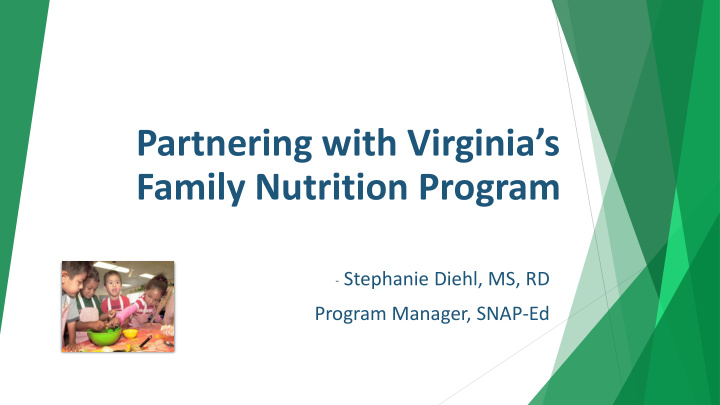



Partnering with Virginia’s Family Nutrition Program - Stephanie Diehl, MS, RD Program Manager, SNAP-Ed
LEAP Curriculum For children 3-5 years of age and their families
Reading to young Literacy children is the single most important factor in academic success Eating Activity What do you do to make reading fun for children? for Preschool
Program Goals Expose the children to different fruits and vegetables they could try at home and school Encourage more physical activity Boost reading skills
Benefits of the LEAP Curriculum LEAP Lessons address: Literacy Activity levels Healthy food choices Easy to Teach Program Facilitator Guide Age appropriate books Reinforcement activities Family newsletter
Lessons Include ✓ Book to read ✓ Food experience ideas ✓ Physical activity and craft suggestions ✓ Parent newsletter
Facilitator’s Guide Suggested book Brief Summary Concepts Objectives Suggestions for Facilitator Discussion Questions Materials Needed Reinforcement Activities Curriculum Matrix
The Gigantic Turnip By Aleski Tolstoy & Niamh Sharkey Activities See, touch, taste and smell a turnip and other veggies Carve turnips to make stamp Theme art Children learn about the turnip and how it grows underground. They see the characters in the book make and enjoy turnip soup after their hard work growing and harvesting this vegetable.
Parent Newsletter Healthy Bits For Families Backpack Newsletters Send these home with the children
OrganWise Guys Nutrition education & incorporated physical activity for elementary schools Kindergarten, 1 st grade, 2 nd grade 6 required lessons
Meet the Organs!
Food Experiences Not required, but encouraged
What is the Extension Agent’s role? Provide the teaching materials Provide support to teachers, if needed Collect demographic and lesson dates from site managers Report data to the USDA grant to ensure funding for future programming!
What is the Teacher’s role? Report class demographics to site manager Report the month and date of lessons to site manager Deliver the lessons - reading the book and discussing health messages Use the suggested activities to provide food experiences, physical activities, and crafts, or create your own activities! Send each student home with newsletters, if applicable
Exploring Preschool Nutrition Education Curricula - Camille McGuire, MS Curriculum Support
Learning About Nutrition through Activities (LANA) & Harvest for Healthy Kids LANA Harvest for Healthy Kids
LANA Learning About Nutrition through Activities
LANA – Overview Hands-on approach Easily adaptable Researched and tested Study showed that children involved in the LANA program 2 : Ate more vegetables at lunch Ate more total fruits and vegetables throughout the day Became less picky and had reduced fear of trying new foods
LANA - Overview Helps children learn to eat more fruits and vegetables by: Increasing opportunities for kids to taste and eat them Providing hands-on experiences with fruits and vegetables Creating a supportive environment Providing children with role models who eat fruits and vegetables Connecting classroom activities with the home environment
LANA - Materials
LANA – 6 Types of Program Activities Menu Changes 1. Frequency: Daily Cooking Activities 2. Frequency: Weekly Tasting Activities 3. Frequency: Weekly Curriculum Theme Units 4. Frequency: Monthly Family Resources 5. Frequency: monthly Special Events 6. Frequency: Bi-monthly
LANA – Curriculum Theme Units Eating the Alphabet 1. Vegetarian Animals 2. Our Senses Teach Us 3. Inside Outside 4. Growing Things 5. Foods for Everyone 6.
Harvest for Healthy Kids
Harvest for Healthy Kids - Overview Promotes healthy eating among preschoolers through repeated exposure to a variety of fruits and vegetables Curriculum was developed using a community-based participatory research process that involved Head Start administrators, food service personnel, teachers, and parents Research-tested Study showed there was a positive association between the intervention and the willingness to try and liking for target foods among children participating in Head Start centers 1
Harvest for Healthy Kids - Materials 13 activity kits for different fruits and vegetables that also teach science, math, and literacy Each kit contains: Hands-on activities with different fruits and vegetables Colorful picture cards Newsletters for families Background information for adults
References 1 . LearningZoneXpress. Research Findings. Learning About Nutrition through Activities 20 1 1 ; http:/ / lananutrition.com/ ?page_id=69. Accessed October, 20 1 9. 2. Izumi BT, Eckhardt CL, Hallman JA, Herro K, Barberis DA. Harvest for Healthy Kids Pilot Study: Associations between Exposure to a Farm-to-Preschool Intervention and W illingness to Try and Liking of Target Fruits and Vegetables among Low-Income Children in Head Start. Journal of the Academy of Nutrition and Dietetics. 20 1 5;1 1 5(1 2):20 0 3-20 1 3.
Brain Storming Session This Photo by Unknown Author is licensed under CC BY-NC-ND
Recommend
More recommend